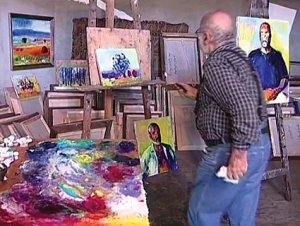Tsira Kalandadze on Art & Her Father
GEORGIA TODAY continues a series of interviews with Georgian painters, together with BI Auction for Art.
In this issue, artist Tsira Kalandadze, daughter of Edmond Gabriel Kalandadze, talks about her family and her famous father- whose works shaped, and to a large extent defined, the contemporary Georgian Art scene, creating an expressive, colorful portrait of the epoch he lived in. Tsira Kalandadze continues the artistic tradition of her family, a brilliant and acknowledged artist herself.
How did your late father influence you?
Our biographies are entwined and related, of course. I’m named after my grandmother Tsira who died when my father was two years old, and it was a story I lived by my entire life. She was 19. Tragically, her sister died, too. My grandmother was buried in a beautiful place in Khidistavi, a village in the region of Guria, in the place she and my grandfather wanted to build a house. It’s a gorgeous place with huge trees, now a village cemetery, and although it may sound strange to some, that’s exactly where life and death unite. I’m telling you all this because it’s a very important part of my father’s biography and my biography, too. From a very early age I knew all these stories and I was encouraged to somehow live with it, analyse and think about it. I spent my childhood in Khidistavi; my father loved being there and we often stayed from May till the beginning of autumn. It was a place full of color, beautiful to see and so enjoyable to experience. My father loved geometry- he knew poetry very well, and at home we had a tradition of reading books aloud. I remember reading all of the children’s literature with him. I loved astronomy and football, and accompanied my father to all the matches at Dinamo stadium. My father always encouraged me to do things independently, without his help, his belief being that there should be nothing I couldn’t do.
What was his reaction when you decided to become a painter?
I was in Khidistavi, as I remember, and one day I very clearly sensed and almost visualized what I wanted to do. I knew it there and then that I would become a painter. I was starting the 8th grade and came back to Tbilisi with a firm decision which I immediately announced to my father. At first, he wasn’t really impressed, and even said he would meet me at the entrance of the Academy of Arts of Tbilisi and stop me from entering, but I guess he just needed to know that I was serious in my wish to become a painter. The interesting thing is that I caught myself working the same way my father did. He used to write down his impressions; fix colors, moods, and atmosphere with a precise description of colors and color palettes. For him, there were no simple definitions for colors- instead of saying simply “yellow” he would call it the color of the fish abdomen or the color of egg-yolk, because that’s how he saw it.
In one of his interviews, he says that one should subordinate color and it should adjust to the motion of your hand…
As you express through paint and color, everything is important… even the way you apply those colors on the canvas. It also depends on the nature of painting, of course. All of it is your arsenal, your language… My father used to work a lot studying other artists’ paintings, making copies in the process; he worked in oil, mostly.
Where does your impulse to create come from?
I honestly don’t know… I always painted…. actually, quite recently, when my twin grandchildren asked me about the colors, I suddenly remembered my own childhood- I remembered loving the color of wine as for me it resembles and is associated with something truly and exquisitely Georgian. But I can’t say where this love comes from, why you love it or how it starts… I remember our house in Khidistavi, with sun-faded wood- maybe that’s what gives me an impulse. In terms of my father, I guess he was largely influenced by his family, which was rather artistic: they wrote, read poems, and made theatrical performances at home. It seems like a different world now…I sometimes say that I’ve witnessed a Georgia and a people that don’t exist anymore.
Did he ever criticize your work and were you afraid of his opinion?
No. The only problem was I didn’t like to show my unfinished works, because then we always started to argue- he didn’t want me to “damage” them and I always tried to prove that it was my right to “damage”. Otherwise, he was always very supportive and never intervened in my working process.
Maybe the reason behind it was that he himself was forced to leave the Tbilisi Academy of Arts where he lectured. He loved what he did, he wanted to be a lecturer, but it became impossible for so many reasons. In those days, even the word impressionism meant something horrible. He was passionate about his work, but I regret that he had too many unaccomplished plans still to realize before he died in 2014.
What would you tell younger artists?
I would suggest they ask questions, analysing why they choose a certain form to work in, and to very carefully choose the material with which they are trying to express themselves.
Nino Gugunishvili











